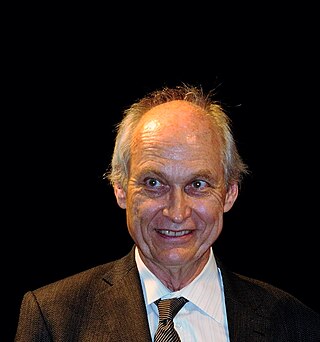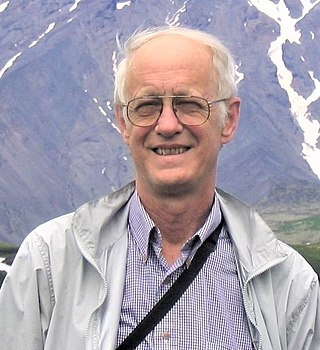Related Research Articles
Donald Edward Osterbrock was an American astronomer, best known for his work on star formation and on the history of astronomy.

Michael S. Turner is an American theoretical cosmologist who coined the term dark energy in 1998. He is the Rauner Distinguished Service Professor Emeritus of Physics at the University of Chicago, having previously served as the Bruce V. & Diana M. Rauner Distinguished Service Professor, and as the assistant director for Mathematical and Physical Sciences for the US National Science Foundation.

Peter Goldreich is an American astrophysicist whose research focuses on celestial mechanics, planetary rings, helioseismology and neutron stars. He is the Lee DuBridge Professor of Astrophysics and Planetary Physics at California Institute of Technology. Since 2005 he has also been a professor at the Institute for Advanced Study in Princeton, New Jersey. Asteroid 3805 Goldreich is named after him.
Edward A. Spiegel was an American professor of astronomy at Columbia University. He worked on convection theory and on the application of fluid dynamics to astrophysics.

Roger David Blandford, FRS, FRAS is a British theoretical astrophysicist, best known for his work on black holes.

Priyamvada (Priya) Natarajan is a theoretical astrophysicist and professor in the departments of astronomy and physics at Yale University. She is noted for her work in mapping dark matter and dark energy, particularly in gravitational lensing and in models describing the assembly and accretion histories of supermassive black holes. She authored the book Mapping the Heavens: The Radical Scientific Ideas That Reveal the Cosmos.
Lars Bildsten is an American astrophysicist, best known for his work on the physics of white dwarfs and their explosions as Type Ia supernovae. He is the sixth director of the Kavli Institute for Theoretical Physics at the University of California, Santa Barbara (UCSB) and a professor in the UCSB Physics Department.

John Frederick Hawley was an American astrophysicist and a professor of astronomy at the University of Virginia. In 2013, he shared the Shaw Prize for Astronomy with Steven Balbus.

Steven Andrew Balbus is an American-born astrophysicist who is the Savilian Professor of Astronomy at the University of Oxford and a professorial fellow at New College, Oxford. In 2013, he shared the Shaw Prize for Astronomy with John F. Hawley.

Ruth Murray-Clay is a professor at the University of California Santa Cruz who studies the formation of planetary systems.
Andrew Robert King, is a British astrophysicist and Professor of Astrophysics in the Department of Physics and Astronomy at the University of Leicester. His previous institutions include University College London and the Institute for Theoretical Physics at the University of Hamburg and a visiting position at the Observatoire de Paris. He currently holds visiting positions at the Astronomical Institute of the University of Amsterdam, and he is a visiting professor at Leiden University. He has served as Editor and now is Deputy Editor-in-Chief of the international astronomy journal Monthly Notices of the Royal Astronomical Society.
Sera Markoff is an American astrophysicist and full professor of theoretical high energy astrophysics at the Anton Pannekoek Institute for Astronomy, University of Amsterdam. She is a member of the Event Horizon Telescope team that produced the first image of a black hole.
Shane W. Davis is an American astrophysicist. He is an assistant professor in the department of astronomy at the University of Virginia. Davis was a senior research associate at the Canadian Institute for Theoretical Astrophysics. He was awarded a Sloan Research Fellowship in 2015.

Kevin France is an astrophysicist and assistant professor in the Department of Astrophysical and Planetary Sciences at the University of Colorado. His research focuses on exoplanets and their host stars, protoplanetary disks, and the development of instrumentation for space-borne astronomy missions.

Ramesh Narayan is an Indian-American theoretical astrophysicist, currently the Thomas Dudley Cabot Professor of the Natural Sciences in the Department of Astronomy at Harvard University. Full member of the National Academy of Sciences, Ramesh Narayan is widely known for his contributions on the theory of black hole accretion processes. He is involved in the Event Horizon Telescope project, which led in 2019 to the first image of the event horizon of a black hole.

Richard Van Evera Lovelace is an American astrophysicist and plasma physicist. He is best known for the discovery of the period of the pulsar in the Crab Nebula, which helped to prove that pulsars are rotating neutron stars, for developing a magnetic model of astrophysical jets from galaxies, and for developing a model of Rossby waves in accretion disks. He organized a US-Russia collaboration in plasma astrophysics, which focused on modeling of plasma accretion and outflows from magnetized rotating stars.
Andrea Ferrara is an Italian theoretical astrophysicist and science communicator.

Giuseppe Bertin is an Italian physicist, known for his work in the explanation of the spiral structure of galaxies, and in the use of these as cosmological probes and gravitational lenses. Bertin is currently Professor at the University of Milan. He won the Premio Presidente della Repubblica in 2013 for his contribute in the latest discoveries in the dynamics of galaxies.

Nikolaos Kylafis is a Greek Theoretical Astrophysicist, who is professor emeritus at the Department of Physics of the University of Crete, Greece.
Barbara Jones is an infrared astronomer. She is a professor emerita at the University of California, San Diego.
References
- 1 2 Blaes, Omer Michael. "CV" (PDF). University of California, Santa Barbara. Retrieved 2019-07-19.
- 1 2 "Omer Blaes: Research Interests". web.physics.ucsb.edu. Retrieved 2021-10-08.
- 1 2 "SGMA interviews: Prof Omer Blaes". American Astronomical Society. Retrieved 2023-06-04.